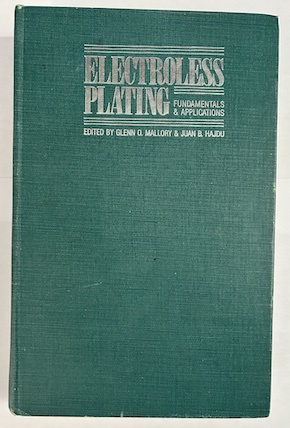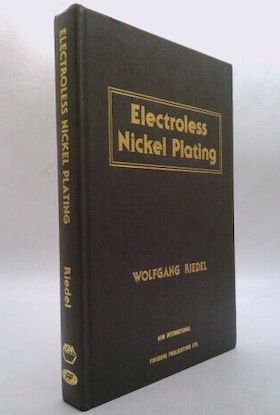
-----
Electroless tin plating of non-conductors
Q. I plated ceramics without conductive material. I used immersion Tin 2% Sn Conc. 5% HCl. I preplate before electroless Ni and Immersion gold to protect nickel from oxidation. I plated ceramics for 15 years but I look for this information myself. I never worked with electroless Sn. Let me know if you find one to develop this chemical. It will save a lot of cost reduction.
Good Luck,
- Myrtle Beach,South Carolina
1999
A. Hi Duang. There are "immersion tins" which will deposit a thin layer onto copper, but unless I missed something, I see no reference to electroless tin plating in such sources as Mallory & Hajdu's "Electroless Plating". I think there is no such thing.
I believe that the issue is a semantics one, i.e., although some people will sometimes call "immersion tin plating / displacement plating" onto copper "electroless tin plating", many professionals reserve the term "electroless plating" for "auto-catalytic" plating (where the solution contains reducing agent that "spring loads" it such that deposition will occur as soon as a catalyst is present, and the plated metal is itself one of those catalysts).
So, while you will find immersion tin / displacement tin plating processes which will deposit onto copper, and some people may call them "electroless tin", I do not think you will find a true "electroless (auto-catalytic) tin plating" solution which can obviate the need for your electroless nickel plating.
Regards,

Ted Mooney, P.E.
Striving to live Aloha
finishing.com - Pine Beach, New Jersey
Ted is available for instant help
or longer-term assistance.
Q. Duang Bouphasavanh,
you mentioned that you used a process to tin plate a nonconductive ceramic? Am I understanding you correctly that you used the electroless tin process to activate a nonconductive ceramic object for electroplating? If this is so, what exactly was the recipe for your solution? I am very interested in this for circuit boards. I've considered Tollens reagent, but silver is expensive and not the best solution.
- Sacramento, California
2003
A, The best way to electro plate non-metals is to use palladium. It is very expensive but it will last forever as long as you use it regularly.
By dipping or submerging the non-metals in the palladium for 5 min, remove and drip dry. Plating electroless or electroplating as normal.
Electronic Designing - Worcester, South Africa
2006
Ed. update: Although starting with palladium "seeds", then electroless copper or electroless nickel was the standard for decades, these days it is also possible to do "direct plating", i.e., applying a graphite-like layer, and then directly electroplating it.
Q. Sir,
We manufacture single and double-sided Printed circuit boards and they are what we call "Roller Tinned" or "Roller Plated" as some people would express the term.
I need to "LEAD/TIN" plate the PCB'S and need a formula. Do explain how this may be achieved by the "Electroless" system and [alternately by] using a rectifier.
Thank you
- New Zealand
2001
A. Hi Christopher. We have many threads on this site covering "tin-lead electroplating", sometimes called "solder plating". Please plug those phrases into the search engine. But in case you are new to this, plating shops and printed circuit board shops virtually never formulate plating solutions from raw chemicals; rather they buy a "tin-lead plating process" from suppliers to the industry who have spent decades in R&D developing the solutions. Although the concept of electroplating is very simple, getting a fine grained, bright, even, well adhering, thick deposit free of pinholes & porosity, and at the various current densities which the board will see is not.
To my knowledge, electroless tin-lead plating is not currently available and perhaps not currently possible.
Luck & Regards,

Ted Mooney, P.E.
Striving to live Aloha
finishing.com - Pine Beach, New Jersey
Ted is available for instant help
or longer-term assistance.
Q. We are making PCBs. The tin plating we need should be Electroless. But how the mentioned processes are possible for the exploitation on Manufacturing Level? Which parameters are critical for maintaining?
I had tried but we got Black slurry & minor tin plating, How to reduce this problem? The Sn was released in Black Granule form I suppose. Then the process will be expensive. How to control Thickness, whatever it may be.
Owner, associate unit - Nasik, Maharashtra , India
July 10, 2008
A. Can you give more information on what you try to accomplish? If I can help you out and I love to solve the problems people had. Thanks,
Duang Bouphasavanh [returning]- Myrtle Beach, South Carolina
Q. I am also Looking for PTH PCB activator material, I have found this formula, but if anyone has a simple & cheap formula, please let me know.
The activation
solution contained
PdCl2 0.4 g/l,
SnCl2 4.5 g/l
HCl (37%) 500 ml/l
- Faisalabad, Punjab, Pakistan
March 8, 2009
A. Hi IFTIKHAR. I believe that Johan Gagiano was correct that PdCl2 chemistry is appropriate and that you are already on the right track with your formula and will not find a cheap formula that can work without palladium.
Luck & Regards,

Ted Mooney, P.E. RET
Striving to live Aloha
finishing.com - Pine Beach, New Jersey
Ted is available for instant help
or longer-term assistance.
A. The process I operated one for etching and follow two rinses tanks and Tin sensitizer bath with two rinses tanks and palladium bath is activator for the electroless nickel to plate. Before I plated nickel after activates and I changed the rack that will help from contamination on my EN bath.
If you want to cut cost of chemicals, it will take at least a month to make sure it passed all test. You have a tin chloride bath : 2%Sn + 5%HCl + 93%DI H2O
Palladium bath : 8%Pd + 92%DI H2O.
It depends who you buy the chemical from.I hope it will help you out. Good Luck,
- Myrtle Beach,South Carolina
Q, A, or Comment on THIS thread -or- Start a NEW Thread

